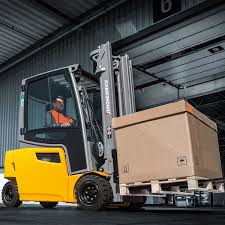Q: Does OSHA requires floors to be marked to designate visitor and employee walkways where lift traffic is present?
Although OSHA no longer has specific floor marking requirements, the General Duty Clause states that an employer shall furnish a place of employment which is free from recognized hazards that are causing or are likely to cause death or serious physical harm to employees. Forklift traffic is a recognized hazard and designated walkways are a standard, best practice control for the hazard. 1910.22(c) also requires safe access and egress. Designated walkways would satisfy this requirement as well.
Q: Is there an OSHA requirement for annual inspections for forklifts or similar powered industrial vehicles?
The short answer is that inspections should be performed much more frequently. Here are best practices for inspection frequency, plus items to keep in mind during preoperational and operational inspections.
Inspection frequency. Forklifts must be examined at least daily before being placed in service. Forklifts used on a round-the-clock basis must be examined after each shift. Defects must be immediately reported and corrected. For more information about all forklift inspection and maintenance requirements, see the rule at 29 Code of Federal Regulations 1910.178(p) and(q).
Preoperational inspection (engine off). Before starting a vehicle, the operator must conduct a pre-operation (or prestart) inspection that checks a variety of items, including, but not limited to:
- Fluid levels—oil, water, and hydraulic fluid.
- Leaks, cracks, or any other visible defect, including hydraulic hoses and mast chains. Note: Operators must not place their hands inside the mast. Use a stick or other device to check chain tension.
- Tire condition and pressure, including cuts and gouges.
- Condition of the forks, including the top clip retaining pin and heel.
- Load backrest extension.
- Finger guards.
Operational inspection (engine on). After completing the pre-operation inspection, operators must conduct an operational inspection with the engine running. This inspection includes:
- Accelerator linkage
- Inch control (if equipped)
- Brakes
- Steering
- Drive control: forward and reverse
- Tilt control: forward and back
- Hoist and lowering control
- Attachment control
- Horn
- Lights
- Backup alarm (if equipped)
- Hour meter
For more information or assistance with your Environmental and Health & Safety regulatory compliance needs, contact Ralph Carito at Total Environmental & Safety, LLC (Total) at rcarito@TotalEnviron.com or 908-442-8599.
Thank you for your continued support. If you like what you read in Total’s Monthly EHS Newsletter, please tell your friends and colleagues.
We always appreciate hearing from you, so if you have a suggestion, comment or gripe, please drop us a line at: contact@TotalEnviron.com or call us at 908-442-8599.
Total Environmental & Safety’s (Total’s) most recent blog. Let us know if you enjoyed it.


